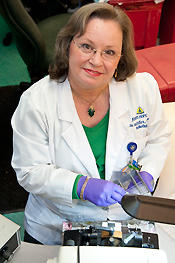 I recently attended the National Society for Histotechnology (NSH) Symposium/Convention in Seattle, Washington, and received a Certificate of Completion for Safety by attending specified safety workshops. One of the workshops was “Green Histology.” I realized that our Lab was not as focused on conservation and reducing hazardous waste as we could be.
I recently attended the National Society for Histotechnology (NSH) Symposium/Convention in Seattle, Washington, and received a Certificate of Completion for Safety by attending specified safety workshops. One of the workshops was “Green Histology.” I realized that our Lab was not as focused on conservation and reducing hazardous waste as we could be.
When Katina Williams, our education coordinator, asked me if I would talk about one of the workshops to our group, I thought “Green Histology” would be the most interesting. I mentioned this to co-workers and some were very interested while others brought up the fact that we had no control over what happened to our hazardous waste. The challenges facing us in an institution of this size made making a difference seem almost impossible. I began to change my thinking and set out on a new course to take advantage of the enormous resources available.
I spoke to Jon Thomas (a familiar face in the lab) from the Safety Department. John is responsible for removing our hazardous waste, and I asked him if he would speak to us about what he does with the waste and where it eventually goes. He was very enthusiastic and spoke to Shane Zuffante of Triumvirate Environmental and asked him to speak to us about where our hazardous waste went after it left Hopkins. Gene Seyfferth, a JHH Biomedical Equipment Technician, also agreed to talk about solution levels and preventive maintenance of our equipment. We set a date for an information-gathering presentation.
Katina Williams and Deborah Duckworth made the arrangements and notified other Anatomical Pathology areas of our plans. Meanwhile, the Lab was already taking measures to conserve on solutions and maximize the life of the stains. Baby steps by baby steps, we were making a difference! Debbie had given me the cost of two of the stains we were focusing on. When I began adding it up, I was amazed. The total savings on the stains alone was $9,488 per year! By reducing the levels of solutions on the stainer by one third, we were not only saving more money, but we were also reducing our hazardous waste. I was very excited about sharing this information.
On February 1, “Planting the Seeds to Go Green” was presented. I thought it was a marvelous success and was very proud of everyone involved. Shane Zuffante from Triumvirate Environmental brought Brian Ryerson, as an added bonus, who talked about what materials could be recycled. The presentation was videotaped, thanks to Jon Christofersen from Path Photo and Arlene Prescott, and will be available soon for the evening shifts and other areas of the Department.
The Anatomic Pathology Employee Engagement Focus Group is getting involved and will be distributing boxes throughout the Department to collect used pens, pencils and markers to help the Johns Hopkins Medicine Green Team. We will be holding our own “Green Histology” workshop soon and will have the chance to exchange ideas to create a safer work environment, reduce hazardous waste, and preserve health on our planet.
Karen Wittler
Histopathology Technologist II
Anatomic Pathology